Jul 28, 2016 | commentary, dollar, US Mint
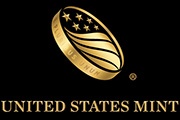 Like almost every business and government agency, the U.S. Mint has been leveraging social media to engage collectors and possibly attract new collectors to purchase coins. One of the places that the U.S. Mint engages the public is on Facebook.
Like almost every business and government agency, the U.S. Mint has been leveraging social media to engage collectors and possibly attract new collectors to purchase coins. One of the places that the U.S. Mint engages the public is on Facebook.
During the last few weeks the U.S. Mint has been appropriately promoting their products but interspersed between their posts are quite a number of posts have been several posts talking about the history of the president featured on the last coin issued in the Presidential $1 Coin program.
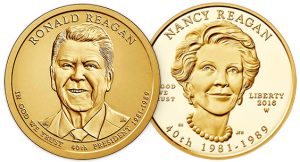
2016 Ronald Reagan dollar & 2016-W Nancy Reagan $10 gold coin
Aside from their over promotion of Reagan on social media, the U.S. Mint has a special section about Reagan’s life on their website. The information rivals something that would appear something on a history-related website or the Reagan Library.
Regardless of how one feels about Reagan, a federal agency should never favor one president over another. If the U.S. Mint has done the same for each of the presidents, then this would not be a problem. But to single out Reagan is counter to the nonpartisan mission of the U.S. Mint.
Why did the U.S. Mint pick Reagan for this type of treatment? Aside from the partisan issues, Reagan’s presidency would not be considered the most historic of those honored on dollar coins released in 2016. Gerald Ford was appointed Vice President in 1973 upon the resignation of Spiro Agnew. This was the first time that someone was appointed Vice President under the terms of the 25th Amendment to the U.S. Constitution. Prior to becoming Vice President, Ford was the House Minority Leader at the time and was well respected by both sides of the aisle.
Ford became the 38th president following the resignation of Richard Nixon marking the first time a president rose to the office without being elected to a national office. Using the 25th Amendment, Ford appointed Nelson Rockefeller (R-NY) as the Vice President.
Aside from presiding over the nation’s bicentennial, his transition from House Minority Leader to President not only tested the constitution but helped prove its strength in society. Although it was a difficult period for economic and world history, Ford was a significant figure in maintaining the union during this time.
Political rhetoric and correctness may have been a driver for the U.S. Mint to single out Reagan. Reagan was just another president compared to the tumultuous rise of Ford. If one president had to be honored for 2016, Ford’s presidency was more historic and deserves recognition.
2016 Presidential Dollar Releases

2016 Richard M. Nixon dollar coin

2016 Gerald R. Ford dollar coin
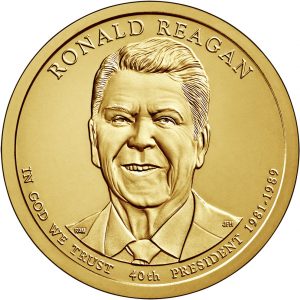
2016 Ronald Reagan dollar coin
All images courtesy of the U.S. Mint.
Jul 20, 2016 | celebration, coins, history, medals
 It was July 20, 1969, Neil Armstrong and Edwin “ Buzz” Aldrin, made history by being the first humans to land on Earth’s only natural satellite. A mere 238,900 mile trip began with the launch of the Saturn V rocket from the Kennedy Space Center on July 16, 1969, with Michael Collins who orbited over the moon in the command module, the trip fulfilled the promise of President John F. Kennedy who said to congress on May 25, 1961, “I believe that this nation should commit itself to achieving the goal, before this decade is out, of landing a man on the moon and returning him safely to the earth.”
It was July 20, 1969, Neil Armstrong and Edwin “ Buzz” Aldrin, made history by being the first humans to land on Earth’s only natural satellite. A mere 238,900 mile trip began with the launch of the Saturn V rocket from the Kennedy Space Center on July 16, 1969, with Michael Collins who orbited over the moon in the command module, the trip fulfilled the promise of President John F. Kennedy who said to congress on May 25, 1961, “I believe that this nation should commit itself to achieving the goal, before this decade is out, of landing a man on the moon and returning him safely to the earth.”
Kennedy would have been pleased with the events of 47 years ago, today.
Michael Collins design the mission insignia. Collins said that he wanted a symbol to represent a “peaceful lunar landing by the United States.” He also left the names of the astronauts off of the insignia so that it would represent everyone who worked on the mission. It is one of the few mission insignias that does not include the name of the astronauts.
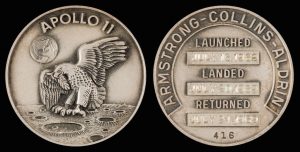
Apollo 11 flown silver Robbins Medal once owned by Wally Schirra
This medal was sold for $33,460.00 on April 18, 2013 by Heritage Auctions.
In March, before the Apollo 11 launch, President Dwight Eisenhower died of congestive heart failure at the age of 78. To honor the late president, congress passed the bill to produce what ended up to be the last large dollar coin with the portrait of Eisenhower. It was Rep. Bob Casey (D-TX) who remembered that Eisenhower created NASA and proposed that the reverse of the coin use the Apollo 11 mission insignia rather than just a heraldic eagle.
The Eisenhower dollar was released in 1971 and struck until 1978. Other than relief and varieties, the only design change was made in honor of the nation’s bicentennial in 1975-76.
-
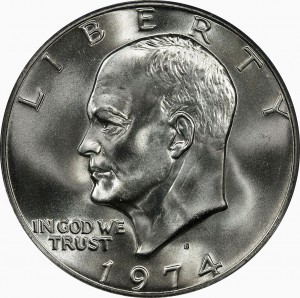
-
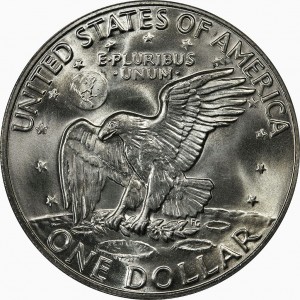
-
Eisenhower Dollar Reverse featuring the Apollo 11 mission insignia
Beginning in 1976, the U.S. Mint was looking to reduce the costs of coin production and was testing different shapes and compositions for a new dollar coin. In order to appease the powerful vending machine industry, the result was a coin that was too similar in size and composition to the quarter dollar. Congress made the decision to honor Susan B. Anthony and leave the Apollo 11 mission insignia on the reverse.
-
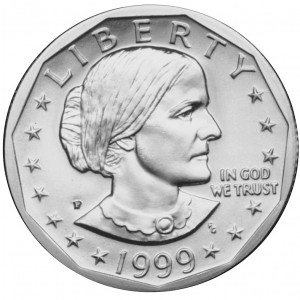
-
Susan B. Anthony dollar
-
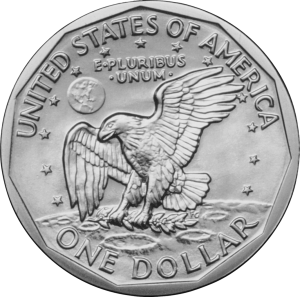
-
Reverse of the Susan B. Anthony dollar featuring the Apollo 11 mission insignia
Chief Engraver Frank Gasparro designed the reverse for both the Eisenhower and SBA dollars using the Apollo 11 mission insignia. An iconic design even though the coins were less than successful.
Credits
- Apollo mission insignia courtesy of NASA.
- Apollo 11 flown Robbins Medal courtesy of Heritage Auctions
- Coin images courtesy of the U.S. Mint.
Jul 19, 2016 | ANA, coins, Eagles, silver
 It has been 125 years since Michigan physicist Dr. George Heath founded the American Numismatic Association in 1891. Heath, who operated a coin business on the side, began this journey by publishing his own magazine in 1888 called The Numismatist. He used the magazine as a call to other collectors to create the ANA.
It has been 125 years since Michigan physicist Dr. George Heath founded the American Numismatic Association in 1891. Heath, who operated a coin business on the side, began this journey by publishing his own magazine in 1888 called The Numismatist. He used the magazine as a call to other collectors to create the ANA.
The ANA will celebrate this milestone at the upcoming World’s Fair of Money. In an interesting coincidence, or maybe planning, the celebration will be help practically next door to the place called “The Happiest Place on Earth.” Irrespective of whatever issues anyone sees or perceives with regard to the ANA, you have to admit that an organization like the ANA to survive 125 years is pretty amazing.
If you are interested in a long-form history of the ANA, I recommend reading “125 Years of Collecting with the American Numismatic Association” written by Q. David Bowers. It is not a quick read, but 125 years of history was not easy to create. The current page is in seven parts with an eighth promised for next month. There is no indication if that will be the last part. Still, it is a recommended article.
Currently, if you become an ANA member or renew your membership for 3 years or donate $125, you can receive a 2016 American Silver Eagle graded MS-69 by Numismatic Guarantee Corporation with a special Anniversary Label. I there is a limit of 2,500 coins. If you become a life member or donate $500, you can receive one graded MS-70. There is a 250 limit on the higher graded coins.
-

-
2016 American Silver Eagle graded MS-69 by NGC with 125th Anniversary Label from the National Money Show
-
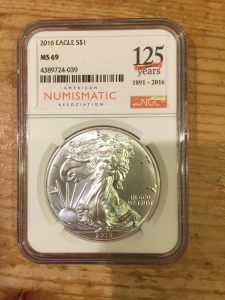
-
2016 American Silver Eagle graded MS-69 by NGC with 125th Anniversary Label
There was also a set of coins created for the National Money Show with a special label. There was a renewal opportunity that allowed existing ANA members to renew and receive their coin with the National Money Show label. These were coins left over from the show in Dallas.
Not only did I take advantage of the renewal offer but added a donation to receive both versions of the coin in MS-65. Although I do not collect grading service labels, this was an opportunity to support the ANA. There may be a limited number of coins left. If you are not a member, you may want to consider joining. If you are a member, either consider a three-year renewal or donate $125 to help the ANA. I believe it is a good cause!
Image of Dr. George Heath courtesy of the
ANA.
Jul 16, 2016 | copper, foreign, history, medals, tokens
A few weeks ago I wrote about the potential effects of Brexit on markets should the Brits vote to leave the European Union. When the OUT vote won by a slim margin, there was an instant worldwide reaction. In the subsequent weeks, we have seen world markets react to everything. After an initial fall in markets because of Brexit they have recovered only to be sent back into uncertainty with world events.
The London PM Gold Fix was $1,265.12 before the polls closed on June 23. The next day, the London PM Gold Fix closed at $1,315.50 (4-percent increase). On July 15, the PM Gold Fix closed at $1,327.00, 4.9-percent increase since the vote. Experts are saying gold could continue to climb at the 4-percent rate for the near future.
Silver has been on a slow and steady rise for most of the spring also saw a bump following the Brexit vote. When the London Silver Fix closed at $17.29 on June 23, this was already a $3.29 increase (23.5-percent) from the January 4 first close of 2016 price of $14.00. After the results were announced, London Silver Fix closed at $18.04, a 4.3-percent increase. With the London Silver Fix closing at $20.14 on July 15 (16.48-percent increase), some pundits are suggesting that silver will continue to outperform gold for the near future.
-
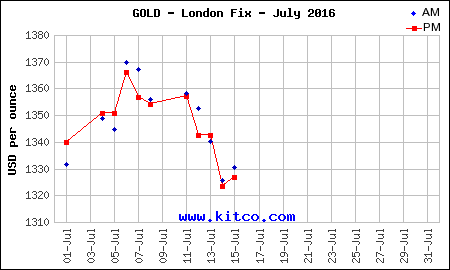
-
Kitco Gold Chart as of 8/15/16
-

-
Kitco Silver Chart as of 8/15/16
When I wrote about Brexit, I also mentioned the “In/Out UK EU Referendum Medallion” produced by Chard(1964), a British metals dealer. After the post, the folks at Chard saw a small bump in sales from collectors the United States from a few of my readers. I was not paid to mention the medal. I just found the information online and thought it was an interesting idea. Shortly before the vote, someone at Chard contacted me and offered to send me some medals.
After a swim across the pond, the medals arrived in my physical mail last weekend. Even though I thought Brexit was a bad idea, the medals are still very cool. Design is the same on both medals. One is copper and the other is Abyssinian Gold, a type of brass made of 90-percent copper and 10-percent zinc that has a gold-like color. Medals are 31mm in diameter and weighs 14 grams making it a nice sized coin for flipping.
-

-
Chard Brexit copper token—IN side
-
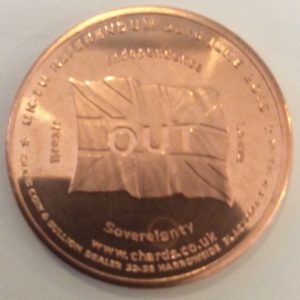
-
Chard Brexit copper token—OUT side
-
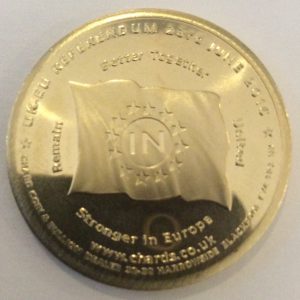
-
Chard Brexit Abyssinian Gold token—IN side
-
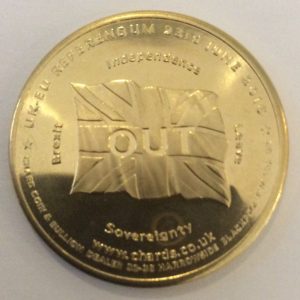
-
Chard Brexit Abyssinian Gold token—OUT side
Chard sent two sets of the medals. I will keep one set and donate the other to my coin club’s annual auction whose proceeds will benefit the Scouts and other numismatic-related education in our region.
It appears that these medals can still be purchased for £2.95 each ($4.33 at the current exchange rate) plus shipping (estimated at £6.00 or $8.80) directly from Chard’s website. I am not making money from this endorsement. I just think it’s a fun collectible!
Static charts courtesy of
Kitco.
Jul 11, 2016 | coins, currency, poll
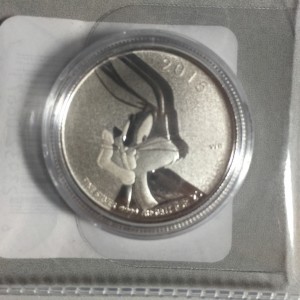
From my collection, a 2015 Canada Bugs Bunny $20 for $20 Silver Coin
I am asking for two reasons: first, I am curious. I know that my tastes are different from yours and I am curious about yours. There is no wrong answer to this question because whatever you like to collect is right for you. It should not matter what anyone thinks of your collection because it’s your collection and you are the one that has to be happy with it. I want to know what makes you happy.
The second reason is so I know a little about who is reading the my blog. It will allow me to could tailor some content to your tastes. It is good for me to stretch out of my comfort zone a bit to learn about something else. But I want to do so in a way that I can write about it and someone will have an appreciation for the content.
The poll is anonymous. The usual set of website logs are kept on the server but it does not identify you or how you voted. Comments are encouraged and moderated only to prevent spam. If you are reading this from a site that aggregates web content, you will have to visit the page on my site in order to participate.

Loading ...
Jul 8, 2016 | BEP, news, US Mint
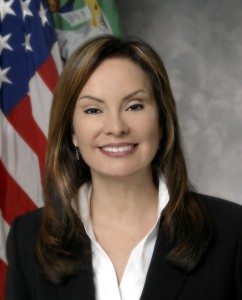
Former Treasurer of the United States Rosie Rios
“Rosie Rios joined the Treasury team nearly eight years ago, during the presidential transition. Since then, she has been a thoughtful steward of two important Treasury bureaus — the Bureau of Engraving and Printing and the Mint — and has been an advocate for women and girls including, for example, her leadership of the Treasury Women in Finance symposium.
“I am particularly grateful for her creativity and leadership in the effort to redesign our paper currency and to ensure that future notes reflect, for the first time in 120 years, the important role of women in shaping our democracy. I thank her for her service and wish her all the best in her future endeavors.”
As the 43rd Treasurer, Rios has been an advocate for everything regarding her oversight of the U.S. Mint and Bureau of Engraving and Printing including her participation at shows. Aside from her signature appearing on every Federal Reserve Note since the 2009 Series, she continued to autograph notes for collectors at conventions. She jokingly calls them “Rosie Dollars.”
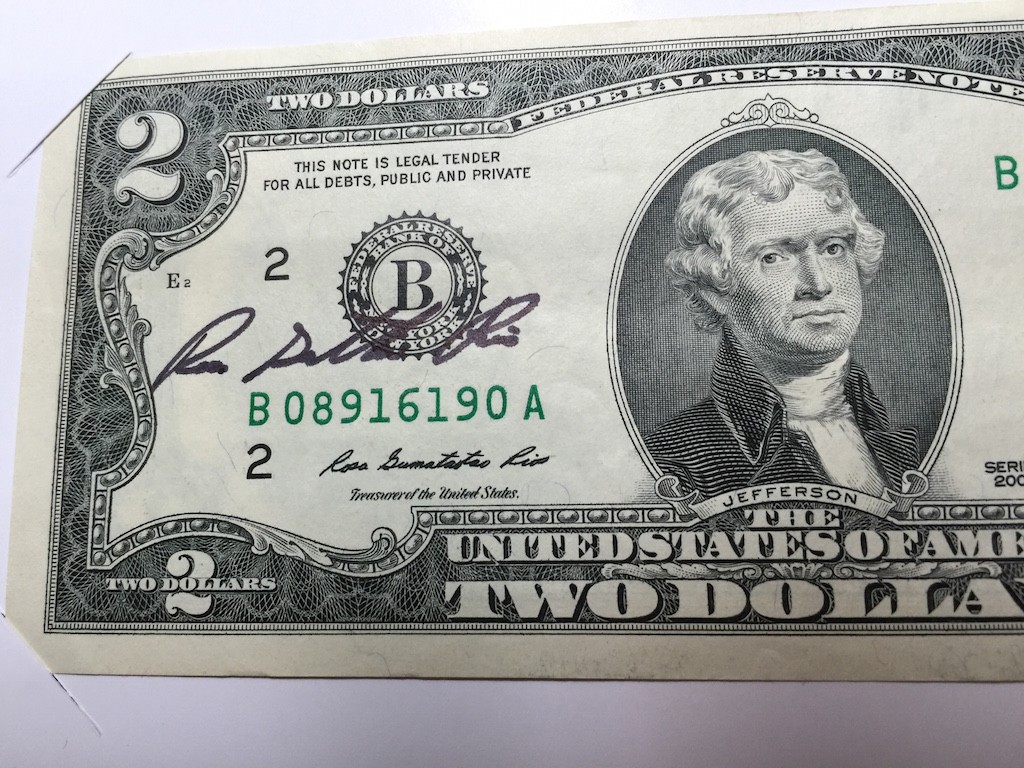
Series 2009 Federal Reserve Note autographed by Treasurer of the U.S. Rosa Gumataotao Rios
Rios has worked as a business executive prior to working on the Obama campaign in 2008 in Virginia. She was hired to work with the transition team on matters concerning the Treasury Department and then was nominated as Treasurer. Rios has been serving as Treasurer since August 8, 2009.
Her future plans were not announced.
Aside from being a tough act to follow, the position may stay vacant for a while. Given the hyper-partisan nature of congress and that we are heavy into this election cycle, it is highly unlikely that the Senate would consider confirming an Obama appointment. Currently, Rhett Jeppson is waiting for a vote to confirm his appointment to be the 39th Director of the U.S. Mint. Jeppson’s nomination was sent to the Senate for “advise and consent” on July 9, 2016. A hearing about his nomination was held on March 15, 2016. The nomination remains in committee waiting for the Senate to do their job and hold a vote.
Jul 8, 2016 | coins, commentary, dollar, Federal Reserve, US Mint

2016 Ronald Reagan dollar & 2016-W Nancy Reagan $10 gold coin
On the Friday before the Independence Day celebration weekend, the U.S. Mint released the Ronald Reagan dollar and Nancy Reagan first spouse coin marking the end of the program.
The Presidential Dollar program has had an interesting history. Passed by congress in December 2005 and later signed by President George W. Bush, the Presidential $1 Coin Act (Pub. L. 108-145) ordered the U.S. Mint to create a $1 coin to commemorate the Nation’s past Presidents and an accompanying $10 gold coin to commemorate the President’s spouse (First Lady). Coins appeared in order that the president served and the president must be deceased for two year prior to the coin’s issue. Since Jimmy Carter is still living, he was bypassed and the last coin was for Ronald Reagan.

2012 First Spouse coin featuring Alice Paul
For the first time in the modern era the date, mintmark, and mottos “E Pluribus Unum” and “In God We Trust” struck into (incuse) the edge of the coin. The last time edge lettering was used on circulating U.S. coinage was in the 1790s.
With the edge lettering a new process for the U.S. Mint, it was no surprised that coins left the Mint without the mottos stamped in the edge. Dubbed the “godless dollar” the error caused an uproar over some people suggesting that the government was conspiring against religion by leaving the motto off of the coin. This was described as either a willful omission or a way to attack religion. There was no narrative that accepted that this was just a mistake.
Our national nightmare ended when congress updated the law (Pub. L. 110-161) to move the motto from the edge to the obverse of the coin. E Pluribus Unum, the date and mintmark was left on the edge.
Then there was the breathless story by National Public Radio that decried the tax dollars being wasted by the approximately $1.4 Billion of dollar coins being stored in the Federal Reserves’ vaults. The story was filled with partial truths and did not properly explain the situation. When I tried to reach out to NPR, I was rebuffed by a reporter who decided a low-level Treasury staffer who did not have the first clue about reality was more credible
While the media was blaming the U.S. Mint and the Federal Reserve, they forgot to read the law. According to the law, there were mintage minimums that congress wrote into the law including the one that said the Sacagawea dollar was to comprise one-third of the dollar coin production. As part of the legislation, the U.S. Mint and Federal Reserve were supposed to promote the coin’s use and provide educational materials for the public.
Congress, who wrote and passed the original legislation, was tripping all over themselves to introduce bills to end the program while pounding their collective chests claiming they were acting in the public interest.
This nightmare ended when then Treasury Secretary Tim Geithner ordered a reduction in the production of all dollar coins. None of the bills introduced to eliminate the dollar coin were ever heard in committee and died at the end of the 113th congress.
But the series couldn’t continue without one more controversy. The way the law was written, it was interpreted that it would end with the first living president. In this case, the program would have ended with the coin honoring Gerald Ford since Jimmy Carter is still living. This did not sit well with the fans of Ronald Reagan who have spent the time since his convalescence and death trying to plaster his name all over everything including an airport that employed air traffic controllers he fired placing the nation’s skies at risk.
The same members of congress that introduced bills to eliminate the program were now demanding the program be extended by one president. Ironically, they waited until after the resignation of Mint Director Edmund Moy and approached the acting Director Richard Peterson. Although Peterson was named acting director, he was a career government employee with impeccable credentials but had to have a different relationship with the politicians than an appointed director would. The matter was deferred to Treasurer Rosie Rios and Secretary of the Treasury Jack Lew who approved the extension of the program.
Presidential Dollars
- 2007:
- George Washington, John Adams, Thomas Jefferson, James Madison
- 2008:
- James Monroe, John Quincy Adams, Andrew Jackson, Martin Van Buren
- 2009:
- William Henry Harrison, John Tyler, James K. Polk, Zachary Taylor
- 2010:
- Millard Fillmore, Franklin Pierce, James Buchanan, Abraham Lincoln
- 2011:
- Andrew Johnson, Ulysses S. Grant, Rutherford B. Hayes, James Garfield
- 2012:
- Chester A. Arthur, Grover Cleveland, Benjamin Harrison, Grover Cleveland
- 2013:
- William McKinley, Theodore Roosevelt, William Howard Taft, Woodrow Wilson
- 2014:
- Warren Harding, Calvin Coolidge, Herbert Hoover, Franklin D. Roosevelt
- 2015:
- Harry S Truman, Dwight D. Eisenhower, John F. Kennedy, Lyndon B. Johnson
- 2016:
- Richard M. Nixon, Gerald Ford, Ronald Reagan
First Spouse Gold $10 Coins
- 2007:
- Martha Washington, Abigail Adams, Thomas Jefferson’s Liberty,† Dolley Madison
- 2008:
- Elizabeth Monroe, Louisa Adams, Andrew Jackson’s Liberty,† Martin Van Buren’s Liberty†
- 2009:
- Anna Harrison, Letitia Tyler,‡ Julia Tyler,†† Sarah Polk, Margaret Taylor
- 2010:
- Abigail Fillmore, Jane Pierce, James Buchanan’s Liberty,* Mary Lincoln
- 2011:
- Eliza Johnson, Julia Grant, Lucy Hayes, Lucretia Garfield
- 2012:
- Alice Paul,¶ Frances Cleveland (first term), Caroline Harrison,‡ Frances Cleveland (second term)
- 2013:
- Ida McKinley, Edith Roosevelt, Helen Taft, Ellen Wilson,‡ Edith Wilson††
- 2014:
- Florence Harding, Grace Coolidge, Lou Hoover, Anna Eleanor Roosevelt
- 2015:
- Elizabeth Truman, Mamie Eisenhower, Jacqueline Kennedy, Claudia Taylor “Lady Bird” Johnson
- 2016:
- Patricia Ryan “Pat” Nixon, Betty Ford, Nancy Reagan
Footnotes:
- †
- President was widowed prior to inauguration
- ‡
- First Spouse died during the president’s term
- ††
- Married the president during the president’s term
- *
- James Buchanan was the only bachelor president
- ¶
- President Chester Arthur was widowed prior to inauguration. However, the authorizing law gives the coin honor to Alice Paul, a suffragette who was born during Arthur’s administration
When the Reagan dollar was issued, 39 presidents representing 40 terms were issued.
Along with Nancy Reagan, 35 other first spouses were honored (Frances Cleveland appeared twice), four different Liberty coins were issued, and one was issued to honor suffragette Alice Paul.

President Reagan horseback riding at Rancho del Cielo with Freebo (his daughter’s dog) and Victory the golden retriever following.
As the program now quietly rides off into the proverbial sunset, maybe it is time to let the America the Beautiful Quarters® complete their run through 2021 and give the circulating commemoratives a rest.
Credits
- Coin images courtesy of the U.S. Mint
- Reagan on horsback “April 4, 1986 photo courtesy Ronald Reagan Presidential Library and Museum.” Downloaded from PresidentialPetMuseum.com
Jul 4, 2016 | celebration, history
After nearly a year of war and attempted negotiation with King George III and the British parliament, it became clear that the colonies in the New World would continue to be under harsh rule without representation. In January 1776, the Continental Congress met to discuss the matter.
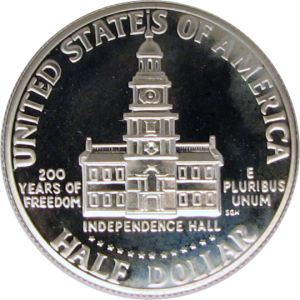 Public support for independence from the British Empire was growing amongst the colonies. Only the “middle colonies” of New York, New Jersey, Delaware, and Maryland who were benefiting financially being part of the British Empire were against independence. When these colonies sent delegations to the Continental Congress, each of their conventions did not allow them to vote for independence.
Public support for independence from the British Empire was growing amongst the colonies. Only the “middle colonies” of New York, New Jersey, Delaware, and Maryland who were benefiting financially being part of the British Empire were against independence. When these colonies sent delegations to the Continental Congress, each of their conventions did not allow them to vote for independence.
As the war with Great Britain dragged on and the attempt at tightening their reigns on the colonies persisted, the populous cry for independence grew. Delegates were set back to their governments and representatives sent to the middle colonies to convince them that the colonies had to declare independence for their own survival. As colonies began to line up with the independence movement, Pennsylvania, New York, Maryland, and South Carolina remained reticent on the subject.
Of the four hold outs, Pennsylvania and Maryland had governments with strong ties to the colonial governors who still had influence. John Adams wrote a draft preamble to explain the independence resolution. Part of the way the resolution was written was, in effect, to overthrow the colonial governments of Pennsylvania and Maryland so that it would be replaced by a popular government. On May 15, 1776, that preamble was passed. The colonies had taken their first step toward independence.
Delegates left the congress and returned to their own colonial conventions. Maryland, whose delegates walked out of the congress in protest, continued to reject the notion of independence. Samuel Chase returned to Maryland and convinced them to allow their delegates to approve the motion of independence. Pennsylvania, New York, and South Carolina remained against the declaration while the Delaware delegates were split.
On June 11, 1776, the “Committee of Five” was appointed to draft a declaration. Committee members were John Adams of Massachusetts, Benjamin Franklin of Pennsylvania, Thomas Jefferson of Virginia, Robert R. Livingston of New York, and Roger Sherman of Connecticut. Although no minutes were kept from the committee meetings, it was accepted that the resulting document was largely Jefferson’s work. The Committee of Five completed the draft on June 28, 1776.
-

-
Robert R. Livingston
-
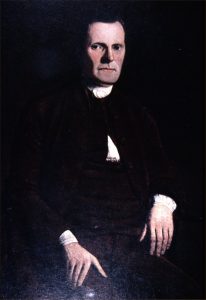
-
Roger Sherman
Debate on the draft declaration began on July 1. After a long day of speeches a vote was taken. Maryland voted yes but Pennsylvania and South Carolina voted no. The New York delegation abstained with out authority from their government to vote. Delaware could not vote because its delegate was split on the question. Edward Rutledge of South Carolina moved to postpone the vote until the next day.
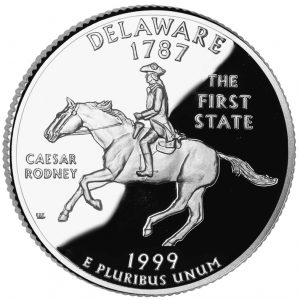 Although there is no written history on what happened that evening, there had to have been lobbying by supporters of independence because on July 2, South Carolina voted yes followed by a turnaround by the Pennsylvania delegation that also voted yes. New York with no authority from their government continued to abstain. With the Delaware delegation deadlocked, this set up the historical ride of Caesar Rodney. Rodney was one of Delaware’s representative to the Continental Congress. He was in Dover attending to other business when he learned that Thomas McKean and George Read were deadlocked on the vote of independence. Rodney rode 80 miles from Dover to Philadelphia to vote with McKean to allow Delaware join eleven other colonies voting in favor of independence.
Although there is no written history on what happened that evening, there had to have been lobbying by supporters of independence because on July 2, South Carolina voted yes followed by a turnaround by the Pennsylvania delegation that also voted yes. New York with no authority from their government continued to abstain. With the Delaware delegation deadlocked, this set up the historical ride of Caesar Rodney. Rodney was one of Delaware’s representative to the Continental Congress. He was in Dover attending to other business when he learned that Thomas McKean and George Read were deadlocked on the vote of independence. Rodney rode 80 miles from Dover to Philadelphia to vote with McKean to allow Delaware join eleven other colonies voting in favor of independence.
With 12 votes for independence and one abstention, the Continental Congress approved the declaration. Jefferson then set forth to make the agreed upon corrections to the document. On July 4, 1776, the Continental Congress approved the wording of the Declaration of Independence. The document was sent to the printer for publication and distribution to the public.
Although historians debate exactly when the final document was signed, it is accepted that the final signatures were added on August 2, 1776. Since New York approved the resolution of independence on July 10, the New York delegation is included amongst the signatures.
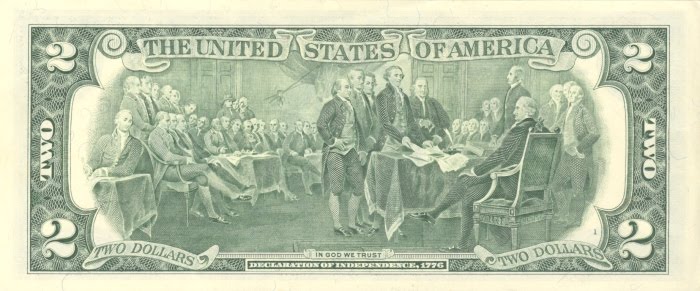

As we celebrate the 240th Birthday of the United States of America, please take a moment to remember those who fought for our freedom and continue to do so today. Honoring them is the best way to honor those whose vision created this great nation.
Credits
- “Declaration of Independence” by John Trumbull hangs in the U.S. Capitol Rotunda and was used as the model for the reverse of the $2 Federal Reserve Note. Image courtesy of Wikipedia.
- Bicentennial half-dollar reverse and Franklin half-dollar images courtesy of the author.
- All other coin images courtesy of the U.S. Mint
- All other images courtesy of Wikipedia.
Jul 3, 2016 | currency, education, Federal Reserve, news, video
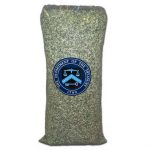
5 lb. bag of shredded currency contains $10K in cash
We have seen the many packages of shredded currency. From the little packages with $5.00 of shredded currency to 5 pound bags filled with approximately $10,000 shredded money, this was the primary way currency did not just get thrown away. Since 2014, the Federal Reserve has been working with recyclers across the country to turn that shredded cash into something else useful.
According to the Federal Reserve Bank of San Francisco, the Federal Reserve pushed for more recycling of currency in 2011. Since each Federal Reserve bank manages its own cash operations each works with local recyclers to provide the cash. In most cases, the recycler hauls away the shredded cash for no charge to the bank and turns it into other products.
Examples of what is done with the cash is that the San Francisco district supports burning of the shreds for “green power,” a fitting name for recycling U.S. currency. So does the Federal Reserve Bank of Philadelphia.
The story caught my eye was about the New Orleans branch of the Federal Reserve Bank of Atlanta that provides shredded currency to a company that composts the cash, mixes it with other soil so that it is used for growing vegetables.
If compost is not your idea of fun, how about using the shreds to make art:
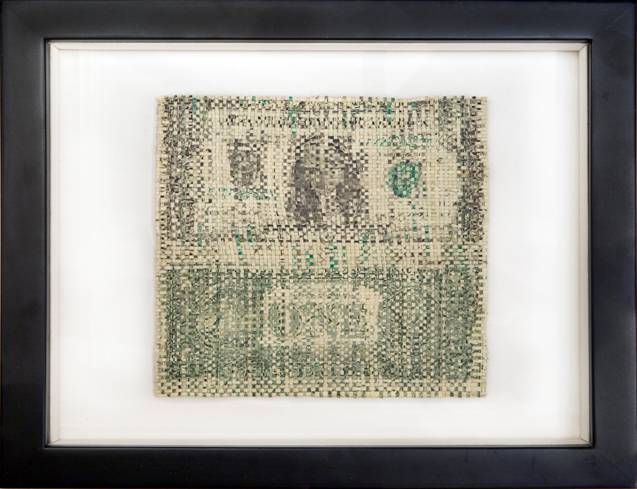
“Another Day, Another Dollar”
Artist: Jason Hughes
Sadat Art for Peace (2012): First Prize, Category: 2 Dimensional
Medium: American Currency
Jul 2, 2016 | coins, commemorative, legislative, US Mint
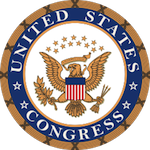 It has been another head scratching month for us policy wonks who watch congress for more than the political theater, although both sides of the aisle provided quite a sideshow this month. With the ever eroding sense of civility, there was a few numismatic-related items that occurred. Introduced as a matched, related bills are proposals for commemoratives in 2020 and 2021:
It has been another head scratching month for us policy wonks who watch congress for more than the political theater, although both sides of the aisle provided quite a sideshow this month. With the ever eroding sense of civility, there was a few numismatic-related items that occurred. Introduced as a matched, related bills are proposals for commemoratives in 2020 and 2021:
H.R. 5598 Plymouth 400th Anniversary Commemorative Coin Act of 2016
Sponsor: Rep. William Keating (D-MA)
• Introduced: June 28, 2016
• Referred to the House Financial Services Committee
This bill can be tracked at https://www.govtrack.us/congress/bills/114/hr5598.
S. 3105 Plymouth 400th Anniversary Commemorative Coin Act of 2016
Sponsor: Sen. Edward “Ed” Markey (D-MA)
• Introduced: June 28, 2016
• Referred to the Senate Banking, Housing, and Urban Affairs Committee
This bill can be tracked at https://www.govtrack.us/congress/bills/114/s3105.
The bill calls for 100,000 $5 gold coins, 500,000 $1 silver coins, and 750,000 clad half-dollar with the usual surcharges ($35, $10, and $5 respectively), to be divided up between five related organizations surrounding the landing of the settlers at Plymouth Rock including 50-percent Plymouth 400, Inc., the organization formed by the Commonwealth of Massachusetts to manage the celebration.
Similarly, Sen. Markey and Rep, Keating are sponsoring bill (S. 3104 and H.R. 5599) “To establish the Plymouth 400th Commemoration Commission.” Not sure why this is necessary since it looks like Massachusetts’ “Plymouth 400” seems to have things covered.
Finally, the Senate Appropriations Committee reported on S. 3067, the Financial Services and General Government Appropriations Act, 2017 which will allow the U.S. Mint to withdraw up to $20 million from the U.S. Mint Public Enterprise Fund for its operations.
 Like almost every business and government agency, the U.S. Mint has been leveraging social media to engage collectors and possibly attract new collectors to purchase coins. One of the places that the U.S. Mint engages the public is on Facebook.
Like almost every business and government agency, the U.S. Mint has been leveraging social media to engage collectors and possibly attract new collectors to purchase coins. One of the places that the U.S. Mint engages the public is on Facebook.
























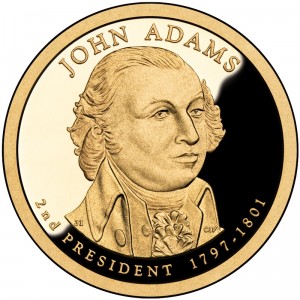
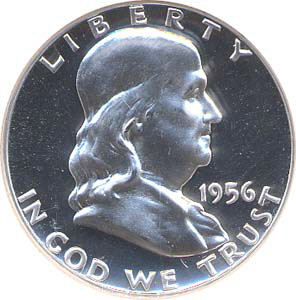



 Although there is no written history on what happened that evening, there had to have been lobbying by supporters of independence because on July 2, South Carolina voted yes followed by a turnaround by the Pennsylvania delegation that also voted yes. New York with no authority from their government continued to abstain. With the Delaware delegation deadlocked, this set up the historical ride of
Although there is no written history on what happened that evening, there had to have been lobbying by supporters of independence because on July 2, South Carolina voted yes followed by a turnaround by the Pennsylvania delegation that also voted yes. New York with no authority from their government continued to abstain. With the Delaware delegation deadlocked, this set up the historical ride of 



 It has been another head scratching month for us policy wonks who watch congress for more than the political theater, although both sides of the aisle provided quite a sideshow this month. With the ever eroding sense of civility, there was a few numismatic-related items that occurred. Introduced as a matched, related bills are proposals for commemoratives in 2020
It has been another head scratching month for us policy wonks who watch congress for more than the political theater, although both sides of the aisle provided quite a sideshow this month. With the ever eroding sense of civility, there was a few numismatic-related items that occurred. Introduced as a matched, related bills are proposals for commemoratives in 2020 
